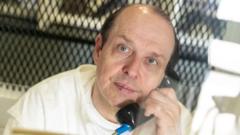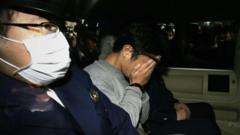Robert Roberson's scheduled execution in Texas was halted by a judge's last-minute order, enabling him to testify in a legislative hearing. The case has attracted widespread attention and support, with many arguing that outdated science played a role in his wrongful conviction for his daughter's death.
Last-Minute Judicial Intervention Halts Execution of Texas Man in Controversial Shaken Baby Case

Last-Minute Judicial Intervention Halts Execution of Texas Man in Controversial Shaken Baby Case
A Texas judge has intervened to stop the imminent execution of Robert Roberson, the first man on death row for a shaken baby murder charge, as calls for clemency grow amidst disputed evidence.
In a dramatic turn of events, a Texas judge has blocked the impending execution of Robert Roberson, the first individual in the United States to be sentenced to death for murder related to "shaken baby syndrome." The execution was set to occur just two hours from the judge's intervention, raising questions about the validity of the evidence used in Roberson's conviction.
Roberson, now 57 years old, has been on death row since 2003, following his conviction for the death of his two-year-old daughter, Nikki Curtis. Prosecutors argued that Nikki died from injuries inflicted by her father; however, Roberson and his supporters contend that she passed away due to complications from pneumonia, rather than abuse. Despite the claims of innocence, prosecutors maintained that new evidence did not conclusively disprove their position.
The last-minute halting of the execution occurred only 90 minutes prior, when a Travis County judge issued a temporary restraining order. The order allows Roberson to testify at a significant hearing set to take place in the Texas legislature next week. This unusual development followed a subpoena issued by a Texas House panel, reflecting growing concerns regarding Roberson’s case.
As the execution deadline loomed, a diverse coalition comprising 86 lawmakers from both political parties, medical experts, attorneys, and notable figures like bestselling author John Grisham rallied for clemency. They voiced concerns that Roberson's conviction relied on outdated interpretations of "shaken baby syndrome" at a time when the science surrounding such diagnoses was not fully understood. "In Robert’s case there was no crime and yet we’re about to kill somebody for it in Texas," commented Grisham ahead of the execution date.
Defense attorneys also emphasized that Roberson's autism, which was undiagnosed during the investigation, was misinterpreted by law enforcement due to his perceived lack of emotion after his daughter’s tragic death. This element of the case drew attention to how autism can affect emotional expression and communication.
Just after the temporary reprieve was granted, the U.S. Supreme Court declined to intervene, leaving the future of Roberson's death sentence in the hands of Texas Governor Abbott. Justice Sonia Sotomayor expressed that it was ultimately the governor’s purview to halt the execution.
The situation surrounding Roberson's case is compounded by the denial of his clemency petition by the Texas Board of Pardons and Paroles, which voted unanimously against recommending a delay or commutation of his death sentence. Governor Abbott, who has historically only granted a reprieve once in nearly a decade, has received personal appeals from Roberson urging him to consider the flawed nature of the facts leading to his conviction.
The brief yet impactful debate continues to raise crucial discussions about the validity of "shaken baby syndrome" diagnoses. Recent medical consensus suggests that thorough investigations into possible alternative causes must precede conclusions attributing injuries to abuse. Roberson’s story highlights the complexities of the criminal justice system and the urgency of reassessing contentious medical diagnoses.





















